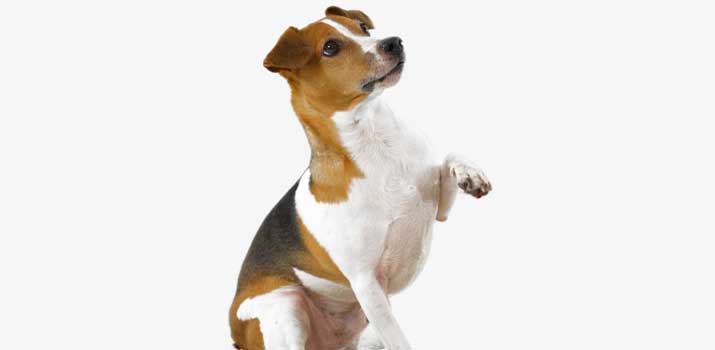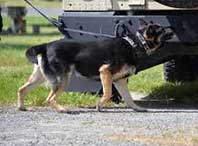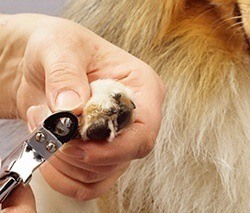While your dog nails may seem similar to the nails on humans, they're quite different in terms of biological composition and function. When people think of the term "nails," they're often referring to clumps of keratin that have to be groomed constantly.
While part of that description certainly applies to your dog's nails,
they're much more complex than most people can imagine.

A more accurate term would be "claws." Your dog's nails actually grow from their individual finger bones. They contain rich blood vessels and nerves. Furthermore, your canine nails are capable of changing based on the dog's activities and grooming patterns.
It's not uncommon to see a dog bleeding from their nails. They're constantly walking on them, using them for digging, snagging them on rough surfaces, and so much more. You may even notice some bleeding when you're cutting your pup's nails.
While a broken nail may be innocent enough for you, it can be a very painful injury for dogs. Because there are so many blood vessels hiding under that hard outer shell, it's not always easy to stop the bleeding.
There are many methods to minimize bleeding and promote healing. The goal after an injury is to kickstart the clotting process. This will make it easier for you to assess the damage and provide your dog with the relief they need.
How to Stop Nails from Bleeding
Whether your dog is bleeding because you accidentally cut the quick or they have suffered an injury during their daily walk, you need to stop the bleeding as quickly as possible. The first thing you need to do is remain calm.
Chances are, your dog is feeling a lot of pain. Creating a panic will only cause your dog to become more scared and anxious.
It's a good idea to get assistance from another person. Your furry friend will not want you to touch their paw. Somebody will need to hold your pooch down and provide some comfort while you stop the bleeding.
You may also need to try more than one of the following methods. Severe injuries might require more attention and professional care.
#1. Apply Pressure
Before you attempt anything else, you should clean up the area and apply pressure. Use a clean paper towel or napkin to contain the blood flow. Minor injuries can often be treated with a bit of light pressure.
This process may be able to kickstart the coagulation process. After a few minutes, check to see if bleeding has slowed down. If not, you can proceed to another technique.
Whatever you do, avoid using alcohol, peroxide, or other common sanitization products. It's almost second nature for many people to go directly to these sanitizers after an injury. However, it's important to remember that dogs do not react to these products in the same way humans do. It may cause a serious allergic reaction. Just use a clean, dry cloth to take care of the blood.
#2. Styptic Powder
Styptic powder is, by far, the most effective way to stop bleeding. It's a vasoconstrictor that's designed to reduce blood flow in a matter of seconds. It's so effective that many groomers and veterinarians have it on hand at all times to address accidents as soon as possible.
You can easily find styptic powders and sticks at our local supermarket, pharmacy, or cosmetics store. It's typically found in the shaving section, as it has been used for decades to stop accidental facial knicks.
Alternatively, you can find a product that's made specifically for dogs. Most of the ingredients are the same, so you can expect the same results.
If you have a styptic stick, you will need to apply a small drop of water to the tip. The water will dissolve some of the powder so that it can get into the nail and restrict the blood vessels. After you have moistened it, simply press it onto the injury.
It's recommended that you rotate the stick as you glide it over the affected area. This ensures that more of the ingredients are spread.
Styptic powder does not need water. In fact, it's recommended that you don't even wipe up excess blood. Mixing with the blood can ensure that more of the beneficial ingredients make it to the injured area. To stop the bleeding, just dip your dog's nail into the powder.
It should be noted that your dog may feel a slight sting. Most styptic products contain silver nitrate, so your pup may react unfavorably upon contact. Make sure that they're relaxed and contained. You don't want your dog to run off and injure themselves even more. Nor do you want to deal with dark silver nitrate stains all over your floors and furniture.
#3. Try a Homemade Remedy
If you don't have any styptic powder on hand, fear not! There are a few household products that can mimic the effects of styptic powder. These include cornstarch, baking powder, and baking soda. The cooking powders are completely safe for your dog. They can be applied one of two ways.
The first way is to create a small pile in your hand. Dip your dog's nail in the powder, cover it with a clean paper towel, and apply pressure for a few minutes to see if the blood with start to clot.
Alternatively, you can add a bit of water to create a thick paste. The paste can then be applied directly into the nail to stop the bleeding. Again, apply pressure for a few minutes.
#4. Use Soap
Yes, you read that right. You can use soap to stop the bleeding. Unscented soap acts as a plug while prompting coagulation. It's important that you use a mild bar of soap that is unscented. The fragrances in soap often contain alcohol, which could result in an allergic reaction.
Soften the soap with some water so that it's not rock hard. Then, glide the bleeding nail across the bar to pick up some soap. You may have to use your finger to direct the soap where you want it to go. Another method is to break off a small piece of soap, soften it, and wrap it around the nail with a clean bandage.
This technique will not work with serious injuries and heavy bleeding. It should only be reserved for light blood flow.
#5. Use Glue
Super glue is a great go-to that can provide you with quick results. While it may sound unorthodox, super glue is relatively safe for dogs as long as it's not consumed. In fact, the active ingredient in super glue is used in surgical applications to close wounds.
Just dab a small amount of clear super glue to the nail. Hold onto to your dog's paw for a few minutes so that they can't lick up the glue before it dries. After only a few moments, the glue should harden enough to stop the bleeding. The glue will fall off after a few days once the nail starts to heal.
#6. Apply a Bandage Wrap
Applying a bandage around your dog's entire paw can help to keep constant pressure on the would. You can wrap the injury up with some gauze and cotton pads to absorb blood.
When you're wrapping, it's important that you pay attention to how tight the bandage is. The goal is not to cut off circulation, but to simply promote clotting with pressure. You can combine this method with others to increase your chances of clotting.
For example, it would be a good idea to wrap the paw after applying styptic or cooking powder.
The Road to Recovery
Stopping the bleeding is not the end of the ordeal. While your dog's pain will certainly be diminished after bleeding has stopped, it won't be gone completely. They will probably be anxious and a bit jittery. You need to keep a close eye on them during the first few hours.
When bleeding has finally stopped, you should clean up any excess blood. You can run the paw under some lukewarm water. It's also a good idea to use some dog-friendly antiseptic. This could provide some sanitation and decrease your chances of infection.
Once your canine companion's paw is cleaned and dried, wrap it in loosely in a bandage. You can create a small amount of pressure, but don't tighten it to the point of being uncomfortable. Keep your pup off his or her feet for at least an hour after the bleeding has stopped.
Let Them Rest
While the injury may seem fine, walking could disrupt the clotting process. Have them lay down in their crate or give them the treat to preoccupy them.
In the next coming days, check on the injury frequently. The area is still delicate, so there's a chance that bleeding can reoccur. Make sure to give your dog plenty of treats to ensure that they don't become fearful of whatever caused the injury.
When You Need to Seek Veterinary Care
Sometimes, these methods will do very little to stop bleeding. Serious injuries can delay the clotting process. If your dog's injury continues to bleed after 20 minutes, you need to see a veterinarian as soon as possible.
Past the 20 minute mark, the chances of clotting decrease significantly. Instead, your dog is at risk of losing a significant amount of blood, which could lead to a host of health issues.
A veterinarian can perform a blood plasma transfusion. This will stop the bleeding almost instantly from within. Your vet will also take that opportunity to examine the issue closely. If there are any complications, such as infection, your vet can address it.
You may also find yourself in a situation where you need to go to a vet immediately after the injury. Cuts that result in a significant amount of the quick being exposed should be taken care of by a professional.
Also, if part of your dog's nail is still having on, don't attempt to remove it by yourself. Doing so could cause further pain and suffering for your dog. It can also lead to improper regrowth, infection, and more.
If your dog is a hemophiliac, you should also go to the vet as quickly as you can. Hemophilia is a genetic clotting disorder that affects dogs of all ages. When these dogs get cut or experience a physical injury, their body is not able to stop the bleeding on its own.
This is because they lack the clotting protein. Ignoring the problem can lead to significant blood loss and death.
Common Nail Injuries
There's nothing worse than seeing your dog trailing blood as they limp along. It can be a very worrisome sight that often sends owners into a panic. Before you ever encounter this problem, it's good to know how it happens.
As mentioned earlier, nail injuries are relatively common. By understanding how these injuries occur, you can take the steps to avoid them.
Hard Walking Surfaces

Your dog's nail consists of hard alpha-keratin that constantly grows to add length. Despite all of its strength, your dog can break a nail by simply walking on a rough or uneven surface.
The keratin naturally wears down as your dog walks. Usually, that wear is not noticeable. However, if the nail is long enough, an abrupt injury can happen from something as simple as jumping the wrong way.
The severity of the break can vary dramatically. In the best-case scenario, the nail breaks off completely. A clean break makes the nail easier to treat.
In the event that the nail is only partially torn or still hanging off by a sliver, you need to take your pup to a vet. Removing the broken portion can be a very delicate process that's only made more difficult by a pup that's in pain.
The best way to avoid a nail injury from hard surfaces is to keep them trimmed. You should not be able to hear the clicking of your dog's nails as they walk. If you do, they're already too long. Chances are, they're putting unnecessary pressure on the nail beds.
Properly-groomed nails will be along enough to provide traction when it's needed, but not long enough to touch the ground during normal situations.
Brittle Nails
If you notice bleeding after a mild walk, your dog may have brittle nails. This is often a result of a vitamin deficiency. Without the proper vitamins and nutrients, the keratin becomes thin and easy to damage.
It's important to consult with your vet for a proper diagnosis. They may be able to recommend supplements or medication to strengthen the nails and prevent further injuries.
Biting
Dogs can gnaw on their nails just like humans do. Canines do this as a way of self-grooming. They know better than anyone else when their nails are getting too long.
Without proper grooming, the nails can get to a point where they cause too much pressure on the toes as they walk. After that, they'll start to curl in on themselves, causing even more problems.
Before it gets to this point, your dog will start to chew on their nails to shorten them. Unfortunately, they don't have the control to make a clean cut. They can cause partial breaks that eventually lead to bleeding. Again, the best remedy to this situation is to keep your dog's nails at the appropriate length.
If you notice that your dog is biting the nails out of stress or habit, you may want to look into behavioral modification training to put a stop to it.
Cutting the Quick

The quick is a cuticle that contains the blood vessels and nerves. If the nails are cut beyond the threshold of the quick, your dog will bleed and feel the pain.
Unfortunately, it's not always possible to see the quick. It's visible in dogs with clear or white nails. However, it's nearly impossible to see in dogs with black nails.
This can be problematic during grooming sessions. Even professional groomers have been known to encounter the quick at some point or another. When the quick is cut, your dog will yelp in pain, pull their paw away, and attempt to lick the blood away.
It's important that you're as careful as possible when clipping nails. Cutting the quick can lead to infection. Not only that, but it will make your dog cower in fear every single time you bring the clippers out.
One unique thing about the quick is that it can change based on the length of your pup's nails. If you let your dog's nails get relatively long, the quick will grow as well. Sadly, this creates a vicious cycle that's not easy to get out of.
Once the quick has reached a certain length, it's impossible to cut the nails back without causing pain and bleeding. You'll need to train the quick to go back down naturally. The only way to that is by slowly shaving the nails bit by bit.
It's a lengthy process that can take months to complete. Even after all that time and effort, it's not always a successful endeavor. It's best just to avoid situations like this altogether by staying on top of your pup's grooming needs.
In Conclusion
Accidents happen from time to time. If it hasn't happened already, there's a very good chance that your dog will bleed from their nails at some point in their life.
As an owner, it's your job to take quick action to put a stop to the bleeding as soon as possible. With these tips and tricks, your dog will be relieved and on the path to recovery in no time.
Also Read: Can you Use Baby Shampoo on Dogs?

